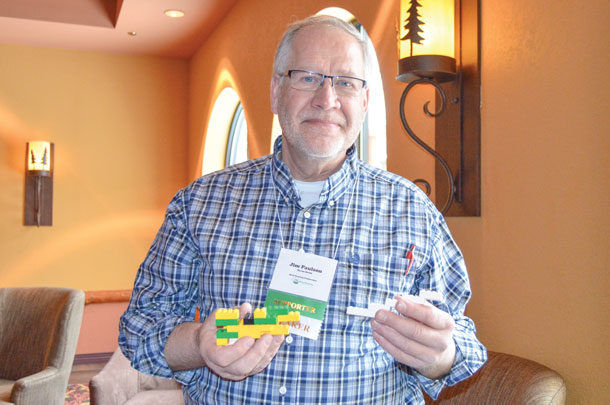How do you do that? Paulson, along with his colleague Dan Olson, grazing dairy farmer and forage consultant, say dry matter intake (DMI) is the most important factor to consider when looking for energy from grass-fed systems.
“It’s about how much the animal is getting in each mouthful and how many bites per hour,” Paulson says. “The ability of an animal to get a full mouthful and have a good supply of feed or pasture is very important to drive total dry matter intake.”
He says grazing too short is not only the most limiting factor for the pasture itself but also for the grazing animals.
Olson says graziers should also look at the amount of digestible fiber cows are consuming. That can be calculated by multiplying the neutral detergent fiber (NDF) by the neutral detergent fiber digestibility (NDFD) to calculate the amount of digestible fiber. He says ideally grass forages should have an NDF of more than 50 percent and an NDFD of 55 percent or higher, to calculate to digestible fiber percentage of at least 30 percent (which is energy for the cow).
Paulson further explains that sugars in plants, typically glucose and fructose, are easily broken down compared to the cellulose in plant fiber because of the complexity of NDF in plants. Starch is broken down almost as fast as sugars and is about 99 percentage digestible. Starch is 85 to 92 percentage digestible, and cellulose in NDF is anywhere from 35 to 65 percent digestible, depending on plant maturity.
“NDF is a percent of dry matter,” Paulson says. “NDF that is digested has as much energy value in calories as does starch. The more NDF we have that is digested means we don’t need as much grain (starch), and this is better for the cow. Sugars in forage are also valuable for the same reason.”
For many years, there was too much emphasis on crude protein (CP), Paulson says. “It’s not about protein; it’s energy we need to be looking at.”
Olson notes too much protein in a ruminant’s diet can actually limit production, as it requires the animal’s energy to process it.
Grasses generally have twice the sugar of legumes but, if it is bagged, the fermenting microbes eat the sugar and create lactic acids. The microbes use up some of the sugars, so not as much fast energy/total energy is left for the animal, he says.
Once grasses are cut, they continue using sugars until they are about 60 percent moisture, reducing the amount of sugars available to the animal. (The amount of reduction varies due to drying conditions and rate of drying.) “The sooner it gets to 60 percentage moisture, the sooner respiration stops. This is why we like wide swaths for making hay,” Paulson says.
When producers are deciding when to start grazing on a pasture or when to harvest forages, they are really deciding how mature they want the NDF, Paulson says. He says NDF is basically measuring what is left after taking out what is inside of the plant’s cells or, in other words, it is a measurement of the cell walls. The more mature the plant, the more lignin there is holding the cellulose together, which makes the plant harder to digest.
Although both grasses and legumes have similar relative feed value (RFV) and acid detergent fiber (ADF), legumes have twice the amount of lignin, and higher crude protein (CP) and minerals but a lower relative forage quality (RFQ). Grasses have a higher NDF but higher NDFD. Graziers should use RFQ to get a better indicator of how well a forage will digest, Paulson says.
“Pasture management within a farm can significantly influence forage quality,” Paulson says, and it can have a bigger influence than season or year.
Factors such as stocking density, the frequency of moves and fertility are part of the management. “Grazing too short is the biggest cause of lost pasture production,” Paulson says.
Variety is as important – or more important – than species choice, he says. “Pastures like diversity; rumens like diversity.”
Paulson recommends a 3-by-3-by-3 approach for pastures, meaning three legumes, three grasses and three others. “I would probably do some alfalfa, red clover and white clover for my legumes. I like meadow fescue, bromegrass and orchardgrass, and then I might add some chicory or plantain and maybe some Kentucky bluegrass to fill in for more sod,” he says. Multiple factors come into consideration when deciding what is best for your operation: soil type and fertility, soil pH and how wet the soil is. Is it wet all the time or just in spring?
If a pasture is all one species such as Kentucky bluegrass or close, it is likely the pasture has been continuously grazed and not managed with rotations and rest periods. In that case, it is best to first address the management before attempting to improve the pasture. Paulson says, “If we don’t, it will eventually end up the same way.” ![]()
PHOTO: Jim Paulson holds Legos to demonstrates the digestibility of forages with some interlocking building blocks. The all-white model resembling a set of stairs represents starch, which easily breaks apart and can be digested quickly and completely. The other model is much more solid and hard to break apart, representing cellulose (yellow blocks) and hemicellulose (green) bound together with lignin (black blocks). The way the cellulose, hemicellulose and lignin bind together are harder to break down, similar to the way mature plants are harder for rumen microbes to break down and digest. Photo by Kelli Boylen.
Paulson and Olson presented this information at the Annual Grassworks Conference held annually in Wisconsin.
Kelli Boylen is a freelance writer based in northeast Iowa.








